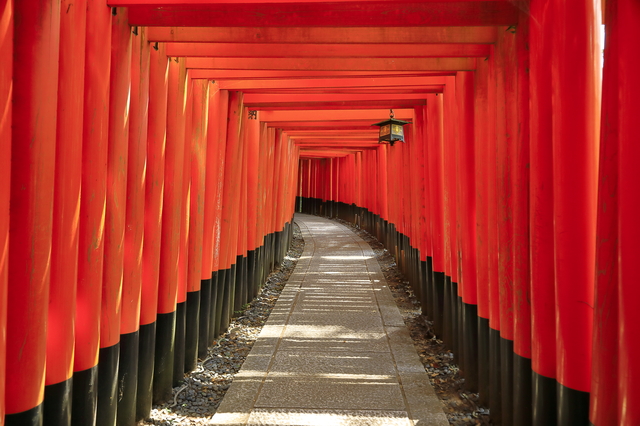In March, April and May, Japan welcomed over 3 million foreign visitors each month. One of the most popular destinations among these visitors is Fushimi Inari Shrine. This shrine captivates tourists with its stunning architecture, rich history, and mystical ambiance, making it a must-visit destination.
Let’s dive in and explore this amazing spot together
Navigating Your Way to Fushimi Inari Shrine from Kyoto Station
If you’re planning to immerse yourself in the enchanting atmosphere of Fushimi Inari Shrine, getting there from Kyoto Station is a breeze. Here’s a guide to help you choose the best travel option.
By Public Transportation
You have two convenient train options to reach Fushimi Inari Shrine from Kyoto Station:
JR Nara Line (Inari Station)
1. Step 1: Hop on the JR Nara Line.
2. Step 2: Head to the JR Nara Line platform at Kyoto Station. You can board any train on lines 9 or 10.
3. Step 3: Enjoy a brief ride and get off at the second stop, Inari Station.
Arriving at Inari Station:
– As you exit the ticket gate at Inari Station, you’ll be greeted by the sight of Fushimi Inari Shrine right in front of you.
Keihan Line(Fushimi Inari Station)
1. Step1: From Kyoto Station, go to a nearby station on the Keihan Line (e.g., Tofukuji Station) and transfer to the Keihan Line.
2. Step2: Get off at Fushimi Inari Station
3. Step3: Walk for about 10 minutes to reach Fushimi Inari Shrine
NOTE: To visit Fushimi Inari Shrine from Kyoto Station, there are two nearby stations: Inari Station and Fushimi Inari Station. Inari Station on the JR Nara Line offers a direct route and is the closest to the shrine. However, if you choose to go to Fushimi Inari Station on the Keihan Line, you’ll find many shops along the way, providing a more immersive experience of the shrine’s atmosphere.
Insider Tip: If you have a JR PASS, use it for this journey for added convenience and savings. Note that the JR PASS can only be used for the journey to Inari Station, not Fushimi Inari Station.
By Taxi (About 15 Minutes)
– Distance: The shrine is just 2.9 miles (4.7 kilometers) from Kyoto Station.
– Fare: Depending on traffic, the fare ranges from 1500 yen (around US$10) to 2000 yen.
Taking a taxi offers a comfortable and direct route, perfect if you have luggage or prefer a more private mode of transport.
The Journey to Fushimi Inari Shrine
Whether you opt for the quick and economical train ride or the comfortable convenience of a taxi, reaching Fushimi Inari Shrine from Kyoto Station is straightforward. Once you arrive, you can fully enjoy the mystical charm of the shrine, exploring its famous torii gates and soaking in the rich cultural heritage.
Discovering Kitsune Udon and Matcha Monaka Ice Cream at Fushimi Inari
When visiting the iconic Fushimi Inari Shrine in Kyoto, there’s more than just the mesmerizing torii gates to explore. Two delightful culinary experiences you shouldn’t miss are enjoying a bowl of Kitsune Udon and a refreshing Matcha Monaka Ice Cream.
What is Kitsune Udon?
Kitsune Udon is a beloved Japanese dish that features udon noodles served in a hot, savory broth, topped with sweet, seasoned fried tofu known as “aburaage.” This combination creates a comforting and flavorful meal that’s perfect for any time of the day.
Why is it Called Kitsune Udon?
The name “Kitsune Udon” translates to “Fox Udon.” According to Japanese folklore, foxes (or kitsune) are believed to have a particular fondness for aburaage. This association stems from their role as the messengers of Inari, the deity of rice, fertility, and prosperity. Inari shrines, such as Fushimi Inari, often feature fox statues, underscoring their spiritual significance.
A Deeper Dive into the Folklore
The connection between foxes and fried tofu has fascinating historical roots. Japanese people have long appreciated foxes for helping control the rat population, which is crucial for protecting crops. In the past, there was a custom of offering fried food to foxes. This practice eventually evolved, influenced by the Buddhist principle of non-violence and a cultural aversion to killing living creatures. Instead of offering fried mice, people began offering aburaage, creating a compassionate and symbolic gesture.
Experiencing Kitsune Udon and Matcha Monaka Ice Cream in Fushimi Inari
Visiting Fushimi Inari is a spiritual journey filled with rich traditions and cultural heritage. After exploring the endless path of red torii gates, a steaming bowl of Kitsune Udon offers a delicious way to rest and reflect. You can enjoy Kitsune Udon at a shop located halfway up the path to the top of the shrine. Please note that the dining area only accepts cash payments, and payment is required in advance. From this point, the path splits into two. According to the shop’s staff, taking the path to the right offers an easier ascent to the top.
On your way up, you can also stop by a shop offering Matcha Monaka Ice Cream. This refreshing treat, made with green tea ice cream sandwiched in a crispy wafer, is perfect for a break on a hot summer day.
So, next time you find yourself wandering through the enchanting Fushimi Inari Shrine, make sure to indulge in some Kitsune Udon and a Matcha Monaka Ice Cream. These treats are more than just meals—they are tastes of Japanese history and tradition in every bite.

Here’s a Concise Packing Guide for Fushimi Inari Shrine
1. Footwear: Opt for sturdy sneakers for climbing the 1,300 stone steps.
2. Cash: Carry small denominations for offerings along the hike.
3. Hydration: Bring water—there are limited places to purchase refreshments.
4. Sun Protection: Sunscreen, a hat, sunglasses, and a neck cooler will combat Japan’s summer heat.
5. Camera: Ensure your camera or smartphone is charged for capturing scenic views.
6. Small Backpack: A light backpack will make it easier to carry your essentials.
Enjoy your journey through Fushimi Inari Shrine with these preparations!


